2005 四川考研英语二真题及答案
Section I Vocabulary
Directions:
There are 20 incomplete sentences in this section. For each sentence there are four
choices marked A,B,C and D. Choose the one that best completes the sentence and mark
your answers on ANSWER SHEET 1.
1. Advertises often aim their campaigns at young people as they have considerable
spending _____.
A. power B. force C. energy D. ability
2. We've bought some ______ chairs for the garden so that they are easy to store
away
A. adapting B. adjusting C. binding D. folding
3. The new speed restrictions were a ______ debated issue,
A. heavily B. hotly C. deeply D. profoundly
4. His change of job has ____ him with a new challenge in life
A. introduced B. initiated C. presented D. led
5. No _____you're hungry if you haven't eaten since yesterday
A. matter B. surprise C. wonder D. problem
6. The pianist played beautifully, showing a real _____ for the music
A. feeling B. understanding C. appreciation D. sense
7. The boss into a rage and started shouting at Robert to do as he was told
A. flew B. charged C. rushed D. burst
8. Politicians should never lose ______ of the needs of the people they represent
A. view B. sight C. regard D. prospect
�
9. The employees tried to settle the dispute by direct _____with the boss
A, negotiation B. connection C. association D. communication
10. You haven't heard all the facts so don't _____ to conclusions
A. dash B. jump C. much D. fly
11. I am _____ aware of the need to obey the vales of the competition
A. greatly B. far C. much D. well
12. The manager has always attended to the _____ of important business himself
A. transaction B. solution C. translation D. stimulation
13. As is known to all a country gets a (an) ______from taxes
A income B. revenue C. rind D. payment
I4,The government has decided to reduce ______ on all imports.
A. fee B. charge C. tariff D. tuition
15. The need for financial provision not only to producers but also to consumers
A. connects B. links C .associates D. relates
16. The ability of bank to create deposits is determined by the ratio of liquid assets
which they___.
A. mount B. contain C. remain D. maintain
17 .The first serious prospect of a cure for Aids_____ a treatment which delays its
effects ha emerged A. other than B. rather than C. more than D. less than
18. His parents died when he was young, so he was ____ by his grandma
A. bred B. brought C. fed D. grown
19.The Japanese dollar-buying makes traders eager to ______dollars in fear of
another government inter
A. let in B. let out C. let go of D. let off
�
20. The local people could hardly think of any good way to ______ the disaster of
the war
A. shake off B. get off C. put off D. take off
Section II Cloze
Directions: Read the following text. Choose the best word(s) for each numbered blank
and mark A,B,C or D on ANSWER SHEET 1.
A few decades ago, the world banking community invented new Electronic Funds Transfer
(EFT) systems to move money more efficiently across countries and around the globe.
The ___21__benefit of such systems was to __22___the float of capital that was
unavailable for ? __23__ checks were being cleared through banking__24__. Today,
we understand that benefits of electronic banking are far more _25__ than just
reducing floating cash. The world of banking__26__revolutionized.It is __27_ more
efficient and faster, but more global. And now_28_the Internet, EFT systems are
increasingly __29__with the new world of e-commerce and e-trade.
__30__1997 and 2003,EFT value__31__from less than $50 trillion to nearly $40
trillion, more than the __32__economic product of all the countries and territories
of the entire world. These statistics__33__should emphasize the true importance of
transnational EFT Satellite, wireless, and cable-based electronic fund transfers
_34__ the hub of global enterprise. Such electronic cash is _35__central to the idea
of an emerging "worldwide mind." Without the satellite and fiber infrastructure to
support the flow of electronic funds, the world economy would grind to a halt.
21. A. hiding B. getting C. driving D. giving
22. A. introduce B. reduce C. produce D. increase
23. A. which B. that C. while D. where
24. A. mechanics B. methods C. procedures D. systems
25. A. extensive B. intensive C. profound D. great
26. A. is B. has C. has been D. had been
27. A. far B. even C. just D. not only
28. A. with B. by C. for D. on
�
29. A. linked B. integrated C. controlled D. joined
30. A. Between B. In C. From D. Among
31. A. decreased B. raised C. elevated D. soared
32. A. gross B. accelerated C. combined D. collective
33. A. lonely B. alone C. only D. merely
34. A. present B. represent C. reserve D. comprehend
35. A. so B. nevertheless C. thereafter D. therefore
Section III Reading comprehension
Directions:
Read the following four passages. Answer the questions below each passage by choosing
A,B,C and D. Mark your answers on ANSWER SHEET 1.
Questions 36 to 40 are based on the following passage:
Working at nonstandard times-evenings, nights, or weekends-is taking its toll on
American families. One-fifth of all employed Americans work variable or rotating
shifts, and one-third work weekends, according to Harriet B. Presser, sociology
professor at the University of Maryland. The result is stress on familial
relationships, which is likely to continue in coming decades.
The consequences of working irregular hours vary according to gender, economic level,
and whether or not children are involved. Single mothers are more likely to work
nights and weekends than married mothers. Women in clerical, sales or other
low-paying jobs participate disproportionately in working late and graveyard
shifts.
Married-couple households with children are increasingly becoming dual-earner
households, generating more split-shift couples. School-aged children, however, may
benefit from parents' nonstandard work schedules because of the greater likelihood
that a parent will be home before or after school. On the other hand, a correlation
exists between nonstandard work schedules and both marital instability and a decline
in the quality of marriages.
Nonstandard working hours mean families spend less time together for diner but more
time together for breakfast. One-on-one interaction between parents and children
�
varies, however, based on parent, shift, and age of children. There is also a greater
reliance on child care by relatives and by professional providers.
Working nonstandard hours is less a choice of employees and more a mandate of employer.
Presser believes that the need for swing shifts and weekend work will continue to
rise in the coming decades. She reports that in some European countries there are
substantial salary premiums for employees working irregular hours-sometimes as much
as 50% higher. The convenience of having services available 24 hours a day continues
to drive this trend.
Unfortunately, says Presser, the issue is virtually absent from public discourse.
She emphasizes the need for focused studies on costs and benefits of working odd
hours, the physical and emotional health of people working nights and weekends, and
the reasons behind the necessity for working these hours. "Nonstandard work
schedules not only are highly prevalent among American families but also generate
a level of complexity in family functioning that needs greater attention," she says.
36. Which of the following demonstrates that working at nonstandard times is taking
its toll on American families?
A. Stress on familial relationships.
B. Rotating shifts.
C. Evenings, nights, or weekends.
D. Its consequences.
37. Which of the following is affected most by working irregular hours?
A. Children.
B. Marriage.
C. Single mothers.
D. Working women.
38. Who would be in favor of the practice of working nonstandard hours?
A. Children.
B. Parents.
�
C. Employees
D. Professional child providers.
39. It is implied that the consequences of nonstandard work schedules are .
A. emphasized
B. absent
C. neglected
D. prevalent
40. What is the author's attitude towards working irregular hours?
A. Positive.
B. Negative.
C. Indifferent.
D. Objective.
Questions 41 to 45 are based on the following passage:
Most human beings actual1y decide before they think. When any human being-executive,
specialized expert, or person in the street-encounters a complex issue and forms
an opinion, often within a matter of seconds, how thoroughly has he or she explored
the implications of the various courses of action? Answer: not very thoroughly. Very
few people, no matter how inte1ligent or experienced, can take inventory of the many
branching
undesired
consequences of a policy or a course of action in a matter of seconds. Yet, those
who pride themse1ves on being decisive often try to do just that. And once their
brains lock onto an opinion, most of their thinking thereafter consists of finding
support for it.
possibilities,
effects,
and
possible
outcomes,
side
A very serious side effect of argumentative decision making can be a lack of support
for the chosen course of action on the pat of the "losing" faction. When one faction
wins the meeting and the others see themselves as losing, the battle often doesn't
end when the meeting ends. Anger, resentment, and jealousy may lead them to sabotage
the decision later, or to reopen the debate at later meetings.
There is a better. As philosopher Aldous Huxley said, "It isn't who is right, but
�
what is right, that counts."
The structured-inquiry method offers a better alternative to argumentative decision
making by debate. With the help of the Internet and wireless computer technology
the gap between experts and executives is now being dramatically closed. By actually
putting the brakes on the thinking process, slowing it down, and organizing the flow
of logic, it's possible to create a level of clarity that sheer argumentation can
never match.
The structured-inquiry process introduces a level of conceptual clarity by
organizing the contributions of the experts, then brings the experts and the decision
makers closer together. Although it isn't possible or necessary for a president or
prime minister to listen in on every intelligence analysis meeting, it's possible
to organize the experts' information to give the decision maker much greater insight
as to its meaning. This process may somewhat resemble a marketing focus group; it's
a simple, remarkably clever way to bring decision makers closer to the source of
the expert information and opinions on which they must base their decisions.
4l. From the first paragraph we can learn that .
A. executive, specialized expert, are no more clever than person in the street
B. very few people decide before they think
C. those who pride themselves on being decisive often fail to do so
D. people tend to consider carefully before making decisions
42. Judging from the context, what does the word "them" (line 4,paragraph 2) refer
to?
A. Decision makers.
B. The "losing" faction.
C. Anger, resentment, and jealousy.
D. Other people.
43. Aldous Huxley's remark (Paragraph 3) implies that .
A. there is a subtle difference between right and wrong
B. we cannot tell who is right and what is wrong
�
C. what is right is more important than who is right
D. what is right accounts for the question who is right
44. According to the author, the function of the structured-inquiry method is .
A. to make decision by debate
B. to apply the Internet and wireless computer technology.
C. to brake on the thinking process, slowing it down
D. to create a level of conceptual clarity
45. The structured-inquiry process can be useful for .
A. decision makers
B. intelligence analysis meeting
C. the experts' information
D. marketing focus groups
Questions 46 to 50 are based on the following passage:
Sport is heading for an indissoluble marriage with television and the passive
spectator will enjoy a private paradise. All of this will be in the future of sport.
The spectator (the television audience) will be the priority and professional clubs
will have to readjust their structures to adapt to the new reality: sport as a
business.
The new technologies will mean that spectators will no longer have to wait for
broadcasts by the conventional channels. They will be the ones who decide what to
see. And they will have to pay for it. In the United States the system of the future
has already started: pay-as-you-view. Everything will be offered by television and
the spectator will only have to choose. The review Sports Illustrated recently
published a full profile of the life of the supporter at home in the middle of the
next century. It explained that the consumers would be able to select their view
of the match on a gigantic, flat screen occupying the whole of one wall, with images
of a clarity which cannot be foreseen at present; they could watch from the trainer's
stands just behind the batter in a game of baseball or from the helmet of the star
player in an American football game. And at their disposal will be the sane option
�
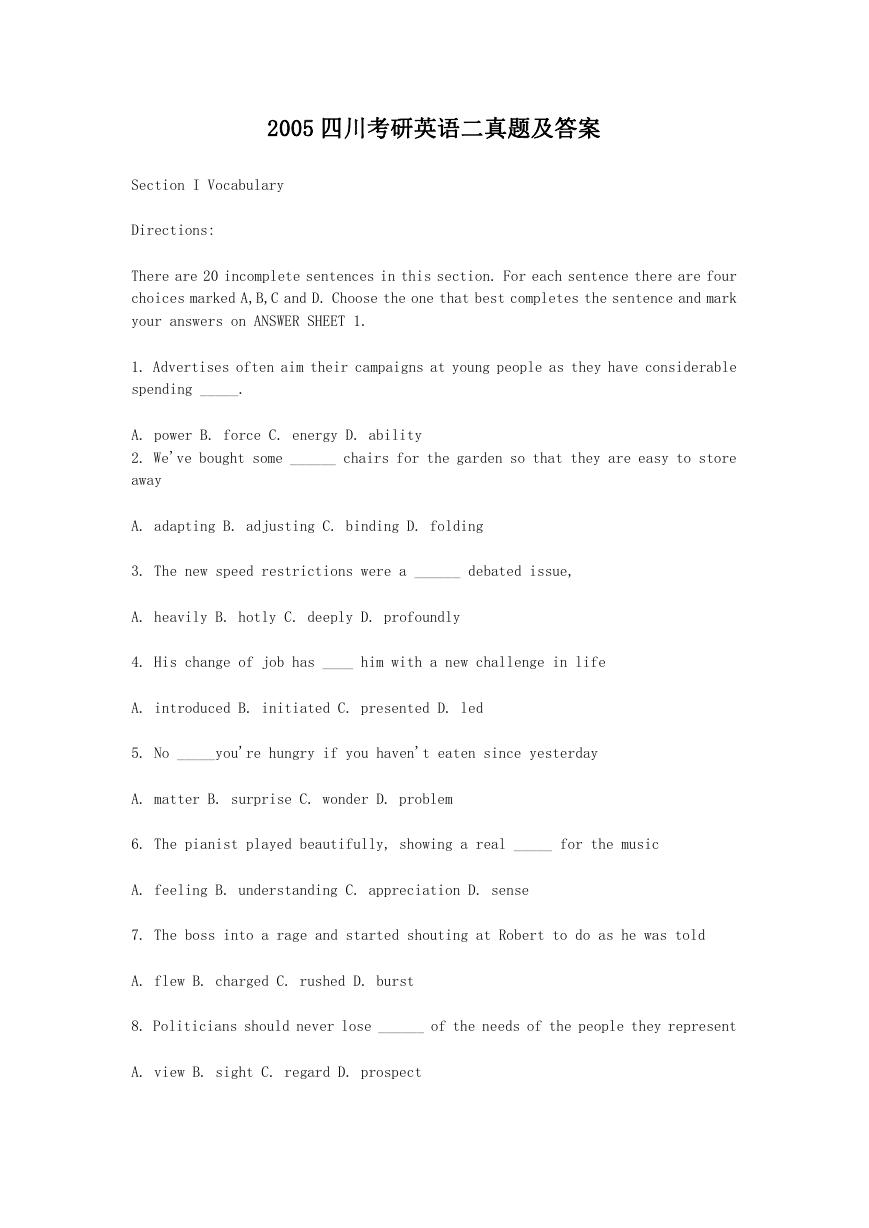
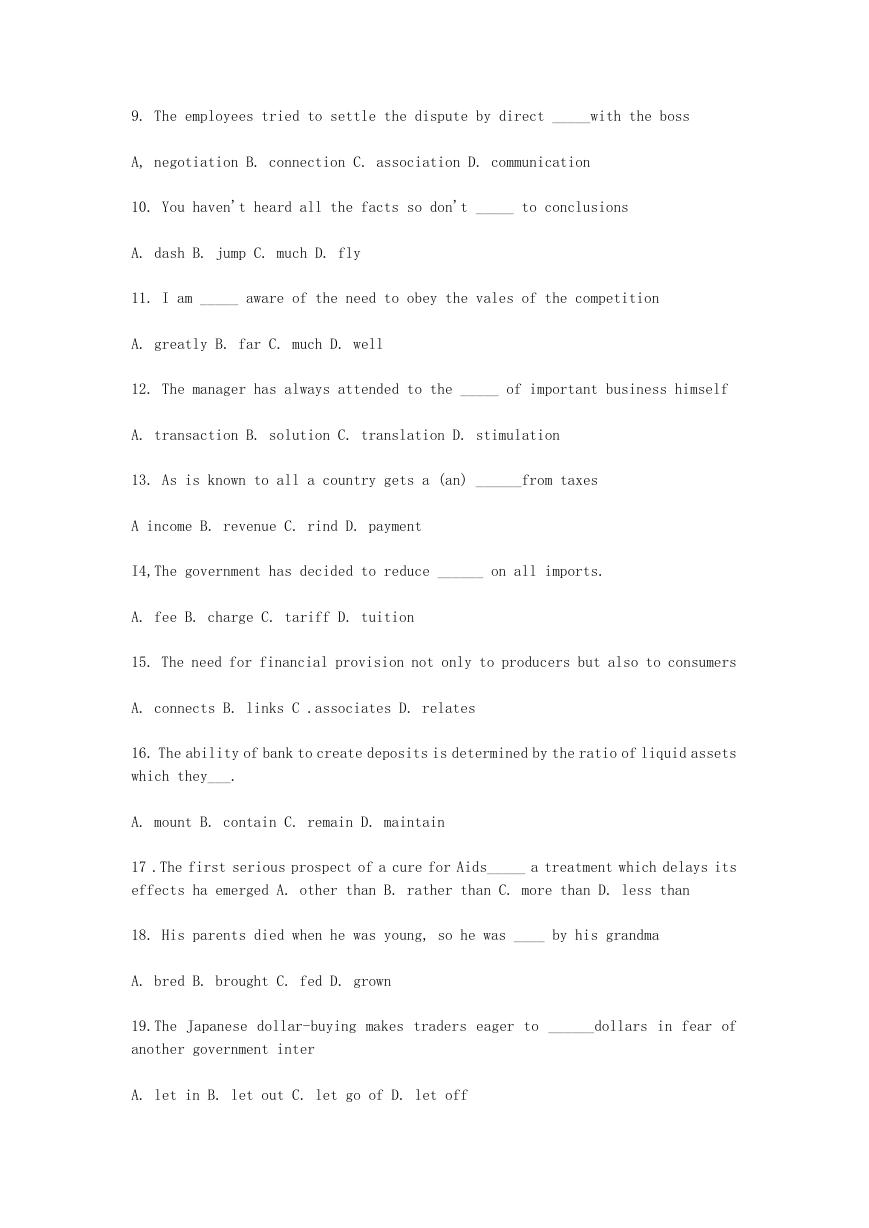
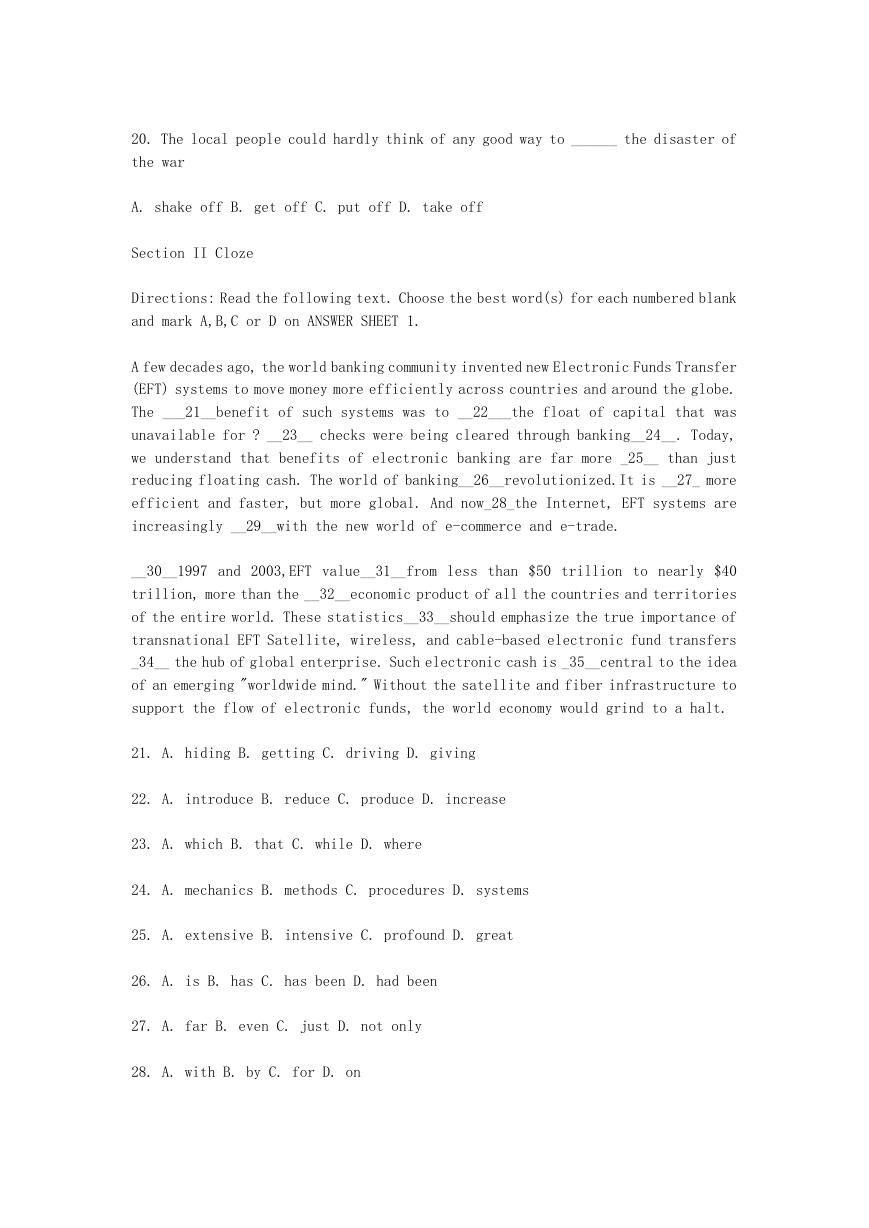
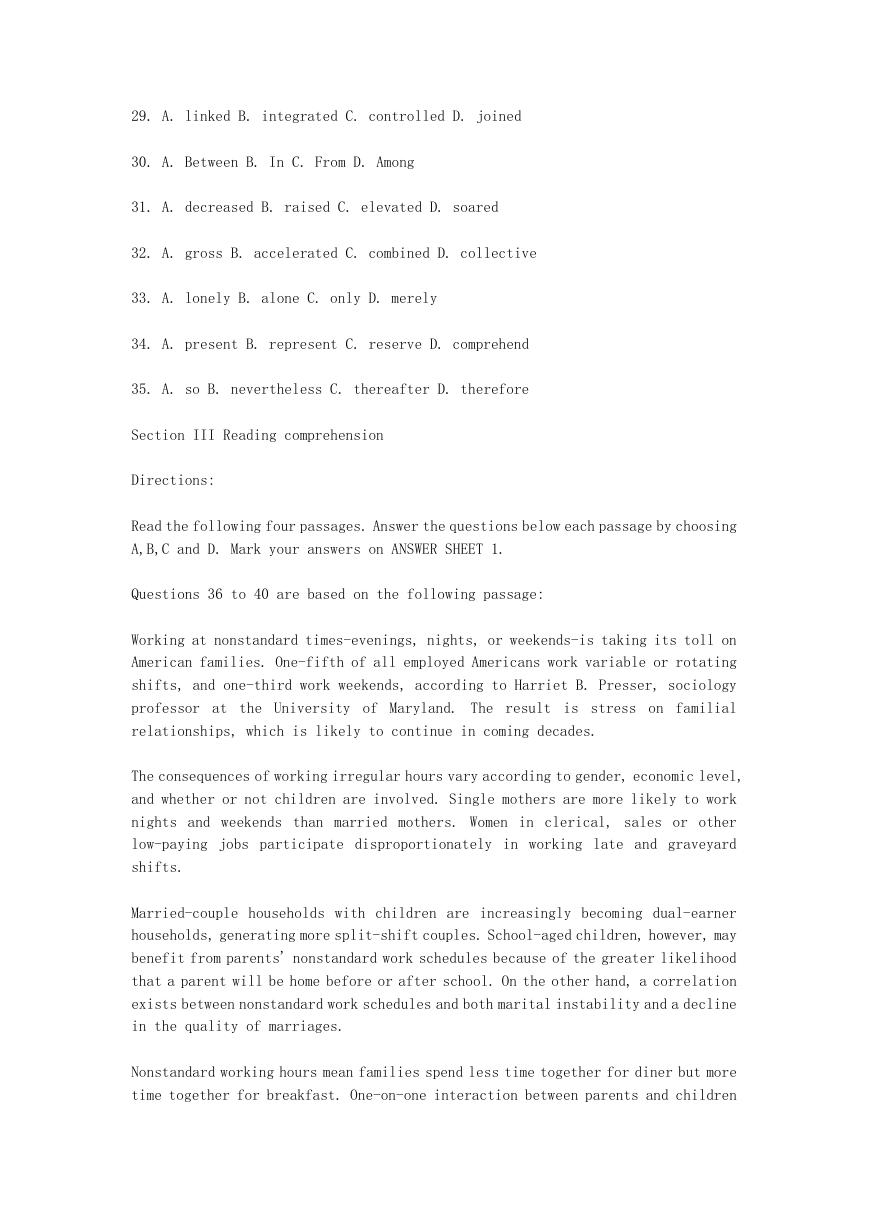

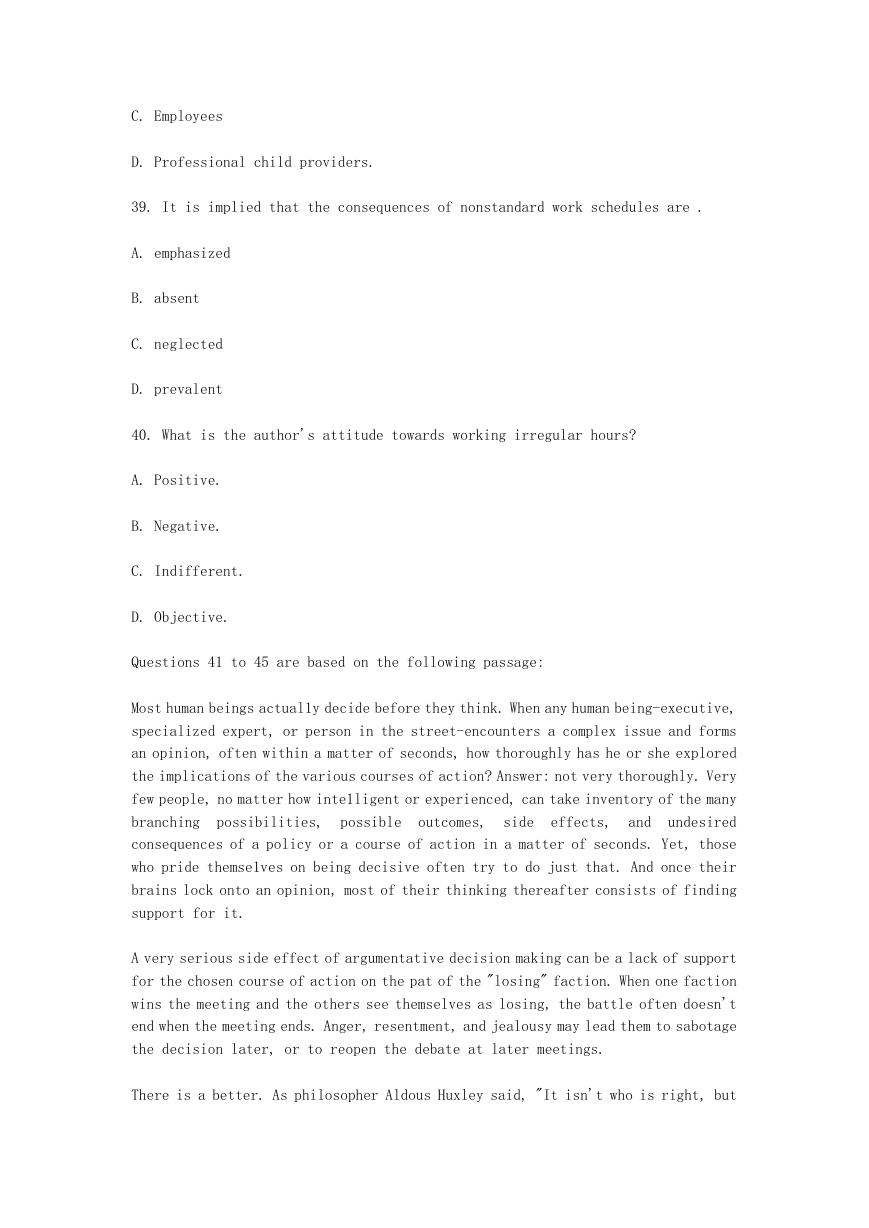
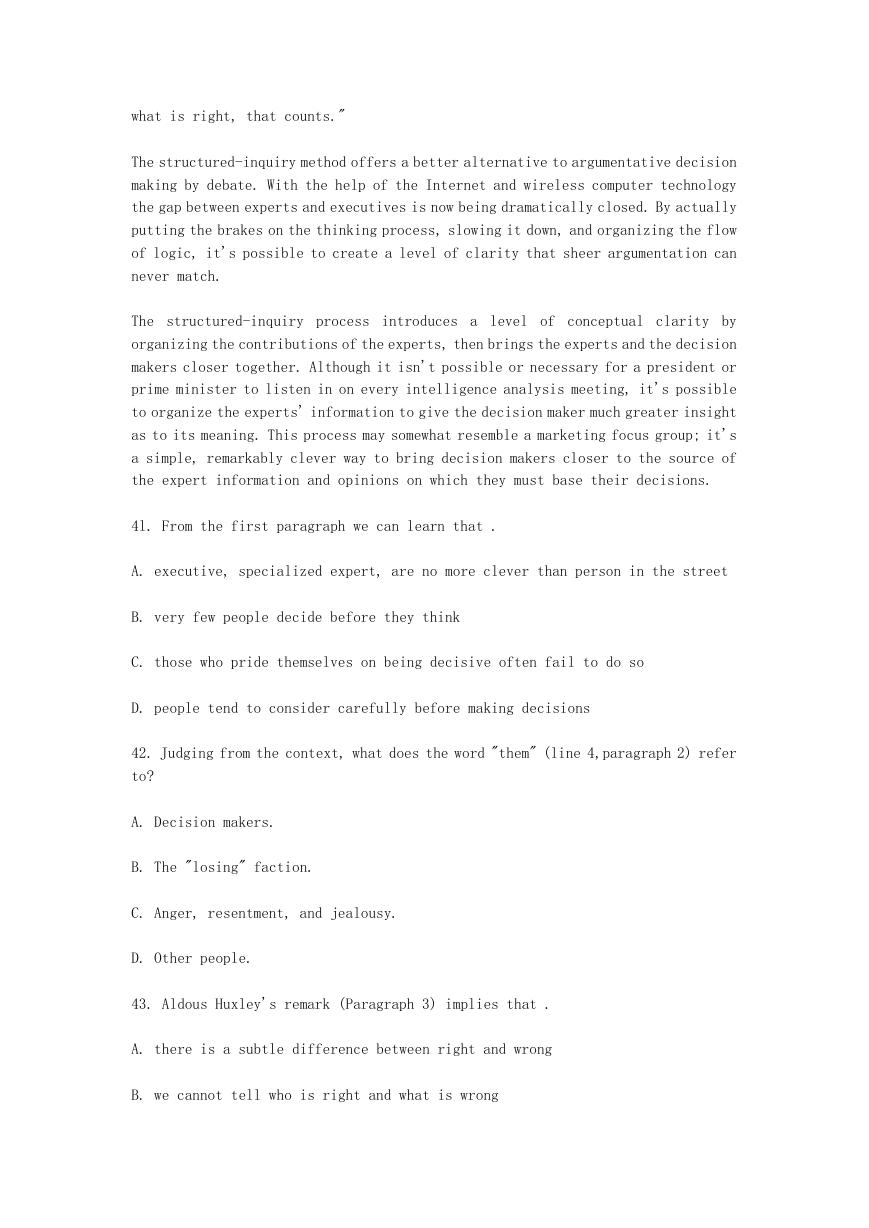









 2023年江西萍乡中考道德与法治真题及答案.doc
2023年江西萍乡中考道德与法治真题及答案.doc 2012年重庆南川中考生物真题及答案.doc
2012年重庆南川中考生物真题及答案.doc 2013年江西师范大学地理学综合及文艺理论基础考研真题.doc
2013年江西师范大学地理学综合及文艺理论基础考研真题.doc 2020年四川甘孜小升初语文真题及答案I卷.doc
2020年四川甘孜小升初语文真题及答案I卷.doc 2020年注册岩土工程师专业基础考试真题及答案.doc
2020年注册岩土工程师专业基础考试真题及答案.doc 2023-2024学年福建省厦门市九年级上学期数学月考试题及答案.doc
2023-2024学年福建省厦门市九年级上学期数学月考试题及答案.doc 2021-2022学年辽宁省沈阳市大东区九年级上学期语文期末试题及答案.doc
2021-2022学年辽宁省沈阳市大东区九年级上学期语文期末试题及答案.doc 2022-2023学年北京东城区初三第一学期物理期末试卷及答案.doc
2022-2023学年北京东城区初三第一学期物理期末试卷及答案.doc 2018上半年江西教师资格初中地理学科知识与教学能力真题及答案.doc
2018上半年江西教师资格初中地理学科知识与教学能力真题及答案.doc 2012年河北国家公务员申论考试真题及答案-省级.doc
2012年河北国家公务员申论考试真题及答案-省级.doc 2020-2021学年江苏省扬州市江都区邵樊片九年级上学期数学第一次质量检测试题及答案.doc
2020-2021学年江苏省扬州市江都区邵樊片九年级上学期数学第一次质量检测试题及答案.doc 2022下半年黑龙江教师资格证中学综合素质真题及答案.doc
2022下半年黑龙江教师资格证中学综合素质真题及答案.doc